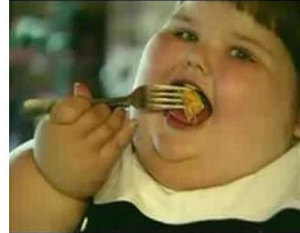
Obesity and overweight are terms that are commonly used interchangeably in children, with overweight being the preferred term. As the prevalence of overweight has increased in children and adolescents, complications of overweight are now well recognized in children.
Pathogenesis:
Overweight results from a dysregulation of caloric intake and energy expenditure. A complex interplay between each individual’s genetic predispositions and the environment affects an intricate system that controls appetite and energy expenditure. Prehistoric ancestors of humans experienced long periods of food scarcity, so energy conservation and storage during times of food availability had a survival advantage.
Diagnositic Criteria for Overweight:
The diagnosis of obesity in adults is based on calculation of the BMI by dividing the weight in kilograms by the height in meters squared (kg/m2). The calculated BMI can overestimate adiposity in trained athletes or muscular children, but it is generally recognized as the most reliable method to determine healthy and unhealthy adiposity. Other methods of determining adiposity are useful, but are either too expensive to be of practical use in a clinical setting (ultrasound, CT, MRI, DEXA, total body conductivity, air displacement plethysmography), require specialized training (skinfold thickness), have poor reproducibility (waist-hip ratios), or lack extensive normative data in children (bioelectric impedance analysis). Therefore, BMI in combination with clinical assessment is sufficient to make the diagnosis.
Children’s adiposity rises in the 1st year of life, reaches a nadir around 5–6 yr of age, and then increases again throughout childhood. This is called the adiposity rebound. The 95th percentile BMI for a 4 yr old is approximately 19, but it is 25 in a 13 yr old. Consistent use of the BMI growth chart aids in early identification of children at risk for later obesity; an earlier adiposity rebound (increase in BMI younger than 5 yr of age) coincides with later obesity.
Evaluation Of Overweight Child:
History:
A family history of Type 2 diabetes, a high-risk ethnicity (African-American, Hispanic, Native American), and central adiposity increase the risk of hyperinsulinism or Type 2 diabetes. Symptoms of polyuria, nocturia, polydipsia, and unexplained rapid weight loss are all associated with the onset of Type 2 diabetes. A history of maternal diabetes or obesity and being large or small for gestational age increase the risk of metabolic syndrome. Snoring, episodes of nighttime coughing fits, or excessive daytime sleepiness can be due to obstructive sleep apnea, which warrants further investigation with referral to a sleep laboratory for polysomnography. A history of wheezing, shortness of breath, or coughing can be due to asthma. Hip, knee, or leg pain is often present due to orthopedic complications. Asthma and orthopedic problems may require treatment and/or alterations in prescribed exercise programs, so identification of these problems during the initial evaluation is important. Irregular menses occur in overweight females with polycystic ovary syndrome.
Physical Findings and Laboratry Screening:
Careful screening for hypertension using an appropriately sized blood pressure cuff is important. Acanthosis nigricans suggests insulin resistance. Tanner staging is useful to identify premature adrenarche. Hirsutism, male pattern baldness, and severe acne are noted with polycystic ovary syndrome.
Treatment:
Successful long-term weight loss in adults is uncommon, despite the wide variety of diet plans and commercial products. There is a propensity to regain weight and adapt unhealthy behaviors with recurrent fad dieting. The most successful approach to weight maintenance or weight loss requires substantial lifestyle changes that include increased physical activity and altered eating habits. Similar approaches are used to prevent weight gain in children who are at risk for overweight and to promote weight maintenance or weight loss in overweight children. Therapies often combine diet, exercise, behavior modification, medications, and rarely, surgery. There is no clear and universally accepted treatment approach, but there are some generally accepted principles.
source:http://easypediatrics.com
 Subscribe to email feed
Subscribe to email feed




obesity is disaster especially in children
Learn about obesity in children, and how you can help your overweight or obese child lose weight, become physically active, and lead a healthy life. Obesity among childhood obesity has more than tripled in the past 30 years the percentage of children aged 6- 11 years in the united states who were obese increased . obesity in leading by example the percentage of overweight children in the united states is growing at an alarming rate, with 1 out of 3 kids now considered overweight or obese. childhood obesity more and more children in the uk are becoming obese .
Childhood obesity - wikipedia, the free e